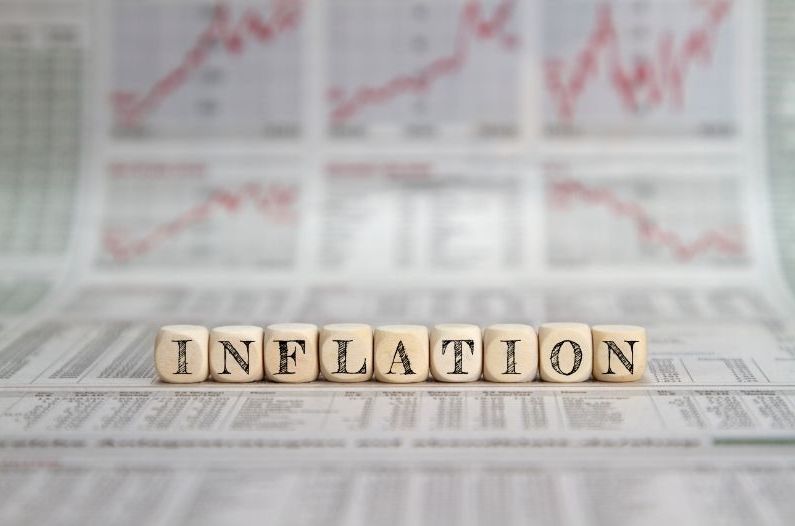January 14, 2022
What’s Going on With Inflation? 3 Reasons Why It’s Here to Stay

By Chris Palabe, CFS®, AIF®
Are you tired of inflation yet? Unfortunately, it’s going to stick around for a while. After months of being told the current inflation crisis is transitory, Federal Reserve Chair Jerome Powell announced that we can expect high inflation to continue into 2022. (1) What may have seemed like a slight inconvenience at first is now becoming a much larger issue as people watch the value of their money degrade right before their eyes with no clear end in sight.
Many people are wondering why the inflation rate has increased so drastically, and we can trace many of the issues back to the COVID-19 pandemic, which was unlike anything the world has ever seen. The entire global economy came to a complete standstill for the only time in modern history. It’s to be expected that the rebound from such a once-in-a-lifetime event will be just as enigmatic as the event itself.
That’s not to say that the future is bleak, but rather to temper expectations so that we can properly plan for the future and mitigate potential risk. Here are some reasons why inflation has increased in the past year and what it means for your long-term purchasing power.
What Is Inflation?
According to Investopedia, inflation is a decrease in the purchasing power of money, reflected in a general increase in the prices of goods and services in an economy. (2) It can be characterized as persistent or transitory. Transitory inflation (3) is temporary and happens when supply doesn’t meet demand. If left unhandled, it can turn into persistent inflation, (4) which results in a more permanent increase in prices due to a continuous mismatch in supply and demand.
The Consumer Price Index (CPI) is a common measure of inflation. The most recent CPI report from November 2021 suggested that inflation has risen an astounding 6.8% over the past year! (5) That is significantly higher than the typical 2% rise we see in an average year.
Why Is Inflation So High?
To better understand if inflation will last, let’s take a look at the factors contributing to its rise.
Devalued Dollar
When the COVID-19 pandemic first hit and millions of Americans were furloughed or laid off, drastic economic measures were taken to keep the country afloat. The U.S. government instituted expansionary monetary and fiscal policies in order to pump money back into the economy, increasing the money supply at a rapid rate. It jumped from $15.5 trillion in February 2020 to $18.8 trillion in October 2020, an increase of over $3 trillion. (6)
Though experts agree that these drastic measures were necessary to keep the economy from collapsing, they also agree that the increase in money supply devalued the dollar, meaning it takes more dollars to buy the same item since each dollar is less valuable.
This issue is further compounded by the current trade deficit, which is sitting at a $174.6 billion (28.6%) year-to-date increase. (7) Because the U.S. buys (imports) more than it sells (exports), a devalued dollar relative to other countries’ currencies drives the cost of imported goods up even more. It’s tempting to write these issues off as fallout from the pandemic, but the trade deficit is not a new issue. In fact, the U.S. has seen a deficit every year since 1975. (8) This indicates that the rise of inflation is not a new issue either, it’s just been sped up and exacerbated by the increase in government spending in response to the pandemic.
Supply Chain Headaches
If there’s one thing that’s been in the news even more than inflation concerns, it’s supply chain disruptions. Since the vaccine rollouts and slow return to pre-pandemic life, companies have struggled to keep up with manufacturing and distributing goods. This is because many distribution centers cut their hours when the global economy came to a halt in anticipation of a huge drop in demand for consumer goods. The drop in demand, however, did not come.
As people across the globe spent days, then weeks, then months in their houses, demand skyrocketed for exercise equipment, home goods, and office supplies. Factories increased their output, but the distribution chains have struggled to get everything where they need to be.
Additionally, the increased production has also caused a shortage in raw materials, thereby exacerbating the gap between overall supply and demand for even basic items. As demand continues to outpace supply, prices are driven higher and higher.
Labor Shortages and Increasing Wages
Continued labor shortages are another factor driving inflation. In what is being called “The Great Resignation,” millions of workers across America have quit or considered quitting their jobs as they reevaluate the role that work plays in their lives. (9) As such, many companies are finding that they have to pay higher wages in order to attract and retain employees. These increased costs often get passed through to the customer in the form of increased prices for goods and services.
The flip side of the labor shortage issue is the passage of the $15 federal minimum wage. (10) Many states are following suit with plans to increase their respective minimum wage thresholds. So even if companies weren’t paying more for labor because of the struggle to find workers, they would still be paying more due to increasing minimum wage. Again, these increased costs will be passed through to consumers, and it will be more than just a transitory change in prices since the minimum wage laws are permanent.
How Long Will Inflation Last?
It’s tough to say exactly how long inflation will last, but based on these three variables, it could be a couple years before we return to the target rate of 2%. As our global economy shifts, trade alliances change, and we experience the ongoing effects of the COVID-19 pandemic, it seems to be an issue that will persist for the foreseeable future.
Let Us Help You Plan Against Inflation
It’s understandable to be concerned about inflation. Many of us are not only worried about how inflation will impact our current finances, but also about how it will affect our long-term goals. That’s why it’s so crucial to be realistic about how long inflation could impact your financial plan.
At Palabe Wealth, we have the tools and expertise to guide you through a long-term inflationary environment. We will review your investment and retirement plans for proper diversification and risk tolerance levels, ensuring you are properly prepared no matter how long this increased inflation lasts. Schedule a 15-minute introductory phone call or call us at 847-249-6600 to learn if we are the right fit for your financial goals.
About Chris
Chris Palabe is the founder and CEO of Palabe Wealth, a financial planning firm providing retirement plan strategies for businesses and individuals. For 25 years, Chris has been serving his clients with customized plans and a boutique approach. He started his firm because of his passion for making a difference in others’ lives and a genuine desire to build long-term relationships with his clients so they can seek to achieve their ideal retirement and manage risk. Chris is a Certified Fund Specialist® (CFS®) and Accredited Investment Fiduciary® (AIF®) professional and has a degree from Université Denis Diderot (Paris VII). When he’s not working, you can usually find him riding horses and competing in dressage at a national level. He also loves reading, watching movies, and eating out. To learn more about Chris, connect with him on LinkedIn.
The opinions voiced in this material are for general information only and are not intended to provide specific advice or recommendations for any individual.
There is no guarantee that a diversified portfolio will enhance overall returns or outperform a non-diversified portfolio. Diversification does not protect against market risk.
This material was prepared for Palabe Wealth Inc.’s use.
____________
(1) https://www.foxbusiness.com/politics/powell-fed-wrong-inflation-not-transitory
(2) https://www.investopedia.com/terms/i/inflation.asp
(3) https://finance.yahoo.com/news/inflation-transitory-persistent-210149448.html
(4) https://finance.yahoo.com/news/inflation-transitory-persistent-210149448.html
(5) https://www.bls.gov/news.release/pdf/cpi.pdf
(6) https://www.statista.com/statistics/1121054/monthly-m2-money-stock-usa/
(7) https://www.census.gov/foreign-trade/Press-Release/current_press_release/ft900.pdf
(8) https://www.thoughtco.com/history-of-the-us-balance-of-trade-1147456

Chris Palabe, CFS, AIF®
Chris Palabe is the CEO and a Financial Advisor at Palabe Wealth, a firm that provides exceptional expertise in the Financial Planning space. For over 25 years, he has cultivated a deep understanding of the complexities of wealth management and retirement planning, making him a valued advisor to both Plan Sponsors of 401(k) plans and Individual Investors.
Holding esteemed designations such as Certified Fund Specialist (CFS) and Accredited Investment Fiduciary (AIF), Chris showcases his commitment to upholding the highest standards of investment advice and fiduciary responsibility in his advisory relationships. These designations are a testament to his knowledge and dedication to providing clients with sophisticated and ethical financial guidance.
He holds his Series 6, 7, 63, and 65 licenses through LPL Financial, which qualify him to offer a broad range of financial products and services.
Chris’s distinguished career is characterized by his unwavering commitment to his clients' financial well-being. He focuses on crafting tailored strategies that aim to optimize retirement outcomes and financial independence. He continually strives to help the individuals he works with on their path towards financial success.
Over the years Chris has refined a consistent, strategic investment philosophy supported by a significant body of academic research. He believes that a widely diversified portfolio of investments tailored to each client’s unique risk tolerance and financial goals is the key to their financial success.
Beyond his professional achievements, Chris has a profound passion for dressage, a highly skilled form of horse riding performed in exhibition and competition. This discipline requires a remarkable level of dedication, precision, and harmony between rider and horse, qualities that mirror his approach to financial planning.






